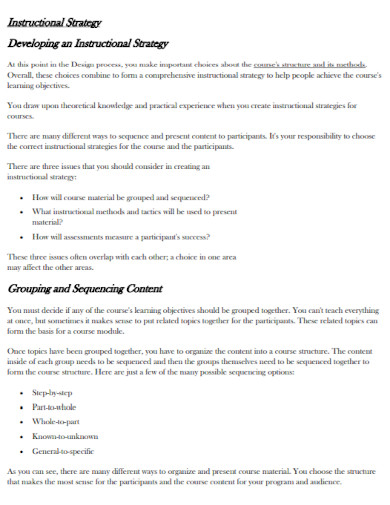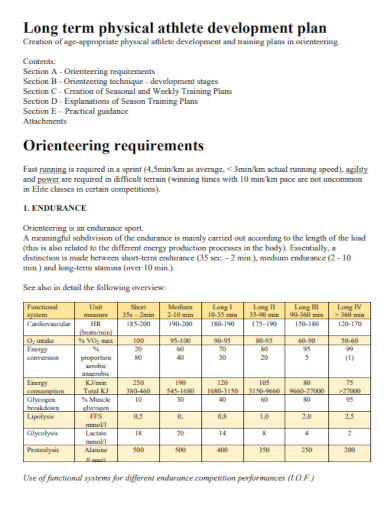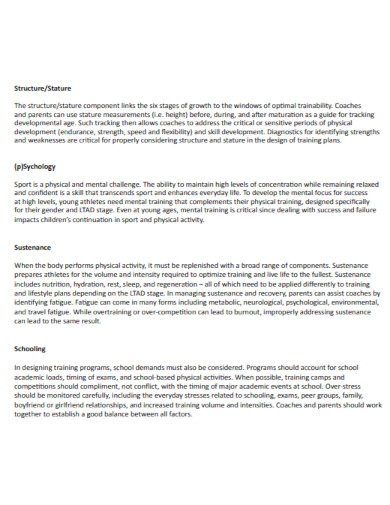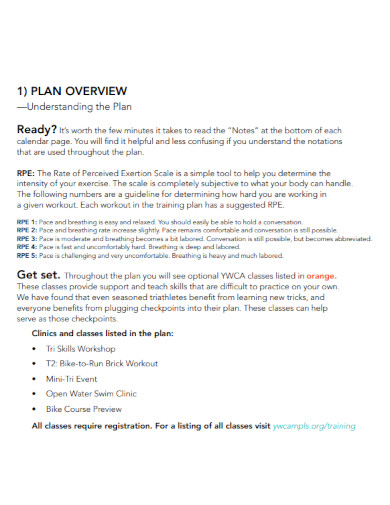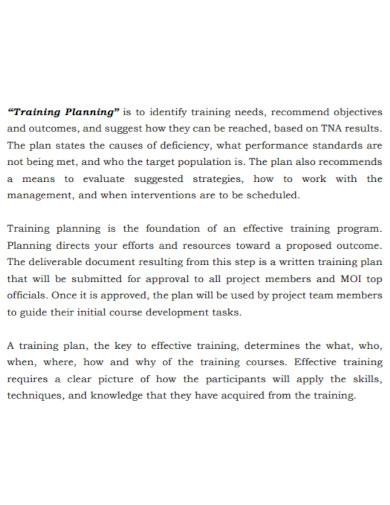5+ Long-Term Training Plan Examples to Download
Whether you are doing this for your business or company or even for your employees to become a better version of themselves, there is no denying that even planning on doing training can be confusing and frustrating since you have to go through a lot of things or roadblocks before you are able to push through it. Especially if it is meant to be a long term training. But even short term training takes a lot of time planning everything out. Queen Elizabeth once quoted that anything you do is done through training. You are able to do anything when you are properly trained. Which of course is true one hundred percent.
But the fact that one must think about planning on it before doing the actual training is tiring in itself. You don’t have to stress yourself on that matter. All you have to do is to check out these 5+ Long-Term Training Plan Examples in MS Word | Google Docs | Pages | PDF This article has you covered for anything and everything that you may be looking for and needed. Now the only thing you should be doing right now is to sit back, relax a bit and start reading now.
5+ Long-Term Training Plan Examples
1. Long-Term Training Plan Template
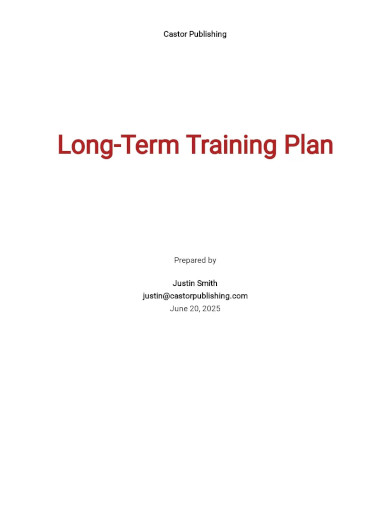
2. Long-Term Strategic Training Plan
3. Long-Term Physical Training Plan
4. Long-Term Athlete Development Training Plan
5. Women’s Long-Term Training Plan
6. Standard Long-Term Training Plan
What Is a Long-Term Training Plan?
What is a long-term training plan and what does it do for you? How can it benefit you or your employees? So a long-term training plan is basically a long term action plan made for the use of training. A long-term training plan consists of the step-by-step information that you want to happen during training. This means that all the information that consists of a training plan is there. This includes the materials, the time, the location and who it is made for. A long-term training plan also consists of the dates that you plan on doing the training. Regardless of the term long-term, it still has or it still needs a deadline for what you may want it to happen.
The Outline Of a Training Plan
So as we know that a training plan consists of a lot of components. But has anyone ever asked themselves what these components are? Not to worry, here is what an outline of a training plan looks like. Short-term training plan or long-term training plans usually or most of the time have the same components in the outline.
1. Title
The first one is of course the title of your training plan. If you want to customize your training plan it is always best to make a title to make it more personal or to be able to motivate you to reaching your goals. Your title would depend on you, as long as your training plan title should go with your objectives. Which is part of the outline and would be discussing through the article.
2. Date
Even if it may be a long-term training plan you are doing, you must add at least a date range for each of the topics and discussions you are going to be doing in the training plan. This is to make sure that you do not have to miscalculate each of the days that you need when you plan on doing your training plan. In addition to that, it is also best to know how long each of the activities that you may be doing, especially when you plan on a long-term training plan.
3. Objectives
The most important part of the outline of your long-term training plan are your objectives. Your objectives must at least be made for the long term as well as the fact that it has to be clear and concise. Your objectives would be the main part of how your training plan would run. Think of your training plan objectives as the stepping stone and the key element.
4. Strategies
The next thing on the outline for your training plan should be strategy. List down all your strategies for each topic you are planning on discussing. Each of your strategies has to be thought out and tried as much as possible. This way, it is better to know if this strategy works for not just a few people but everyone in the majority. A good strategy comes from a well thought out plan and a well thought out trial. Of course not all strategies can be considered a good one but it is better than nothing.
5. Topics
The fifth part of the outline is your topics. This is part of your long term training plan. This is the heart if the objectives were the backbone or the key, the topics are the heart of your training plan. Plan on the topics that you want to be talking about and what you want out of it. Your topics must go with your objectives and the whole training plan agenda. Your topics must also if possible be connected with one another.
6. Materials
The materials could range from simple to complex. From card stocks, markers, papers, pens, and even projectors. Any materials that you think can be of use must be stated below. As long as there is any type of material being used for your training plan, you must write them down. Bullet form is usually a good format for this when you are going to be writing a lot of the materials used.
How To Write a Long-Term Training Plan?
You may ask yourself, is a long-term training plan difficult to write? It actually is not. But having to think about what to write first may be a challenge in itself. But this is what the article is for. To help you with that all you need to do is to begin your first step with your long-term training plan.
1. Do an Assessment for Needs
First thing, before doing your long term training plan, you must do an assessment. Assess the needs of your employees to see which of the right topics should be discussed. This way you would not have to waste anymore time or materials to know which should be done and which should be disregarded. The main reason for the assessment is to know where to focus on. Which of the categories that may already be in your company that your employees may need improvement on. This is your target for making your long term training plan.
2. Make Your Objectives Match Their Needs
Your objectives should match the evaluation from the assessment of needs. Your objectives should be clear and specific as possible Remember that your objectives also matter at this point. What you want to achieve is written within your objectives. Adding to the fact that they must also hit the target of your training plan. The minimum number of objectives is three and a maximum of five. As long as your objectives correlate to one another but are not repetitive.
3. Begin Your Training Plan
Once you have gone through both the tips, it is time you begin writing out your long term training plan. Add the necessary information as well as the outline of how you want your training plan to look. In addition to that, you must also add the result of the assessment done, the dates, the level of your training and the people who are your targets for this training plan.
4. Evaluate Your Training Plan
This may sound risky or tricky depending on how you devise your training plan. But this is still as necessary as the rest of the tips. Evaluate your training plan by taking a few participants and start from there. If you can see the strategies working for the majority of the participants, and your objectives being met, then use the result as a way to improve or change.
5. Revisions When Necessary
Always be open for any improvement made on your long term training plan. Remember that each participant in your training plan has a different set of learning curves. What may work for others may not work for them. Revise when you can. It is always good to have your training plan improved. This does not mean that it is not working, rather it is a good idea to know from the evaluations that there may be some parts of your long term training plan that could be open for revisions.
FAQs
Why is a long-term training plan important?
The purpose of a long-term training plan is to make sure that there is still space for improvement. The training plan is your stepping stone for a better work improvement. Your long-term training plan should consist of the important components as well.
What are the key components of a long-term training plan?
The key components of a long-term training plan are: Title, Date, Objectives, Strategies, Topics, and Materials. Of course you may add more if you wish but these are the most common components expected in a training plan. Whether it may be short term or long term, expect these types of components.
What is one thing that should be avoided in a training plan?
Avoid saying you are not going to improve or revise your training plan. Keep an open mind when doing your training plans, as every employee you train has their own learning curves, and no two employees have the same learning curves or the same needs. Keep in mind that with each assessment and evaluation, you must keep your training plan up to date. This means, you should not ignore the idea of having to revise it when necessary.
This is the end of the article about long-term training plans. We have discussed what a long-term training plan is, as well as touching the purpose for writing one. We have also discussed the components and how to make your own long-term training plan. What should always be remembered is that your long-term training plan would only work if you understand that revising, assessing and evaluating play vital roles in it as well.



